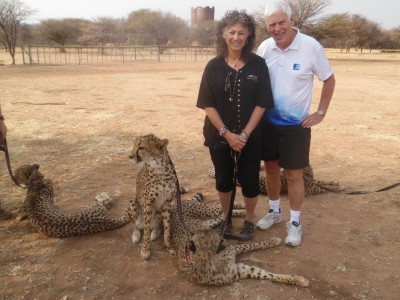NSU Newsroom
SharkBytes
Horizons
This version of NSU News has been archived as of February 28, 2019. To search through archived articles, visit nova.edu/search. To access the new version of NSU News, visit news.nova.edu.
This version of SharkBytes has been archived as of February 28, 2019. To search through archived articles, visit nova.edu/search. To access the new version of SharkBytes, visit sharkbytes.nova.edu.
Halmos Professor Travels to Africa for Conservation Efforts

Stephen O’Brien, Ph.D., professor at NSU’s Halmos College of Natural Sciences and Oceanography, recently traveled to Namibia where he met with Laurie Marker, D.Phil., a world-leading researcher, conservationist, and founder of the Cheetah Conservation Fund (CCF). The cheetahs (seen in photo) are Africa’s most endangered big cat.
Stephen J. O’Brien, Ph.D., professor at NSU’s Halmos College of Natural Sciences and Oceanography, recently traveled to Africa to participate in collaborative international efforts focused on world species conservation.
O’Brien’s first stop was the Cheetah Conservation Fund (CCF) in Namibia, which is led by international conservationist Laurie Marker, D.Phil., a world-leading researcher and expert on the cheetah, Africa’s most endangered big cat. Marker founded CCF in 1991 in Namibia, a country in southwest Africa where the species is most prevalent. CCF preserves more than 100,000 acres of cheetah habitat. O’Brien and Marker described remarkable genetic uniformity of cheetah species in back-to-back studies published in Science magazine in the early 1980s.
In 2015, Marker and O’Brien and colleagues at the Theodosius Dobzhansky Center for Genome Bioinformatics in St. Petersburg, Russia, released and published in-depth analyses of the whole genome sequence of a cheetah rescued by CCF.
Marker will visit NSU’s Oceanographic Campus for a lecture and reception on November 12, 2016, as part of a five-week, 13-city U.S. speaking tour. Marker, a zoologist, research scientist, and conservation biologist, is working to raise awareness of the cheetah plight and raise funds for continued conservation efforts.
During the trip to Africa, O’Brien was part of a site review team at the University of Pretoria’s Life Sciences program, including the Onderstepoort Veterinary Institute.
He also collaborated with Cindy Harper, MSc, who manages the Veterinary Genetics Laboratory at the University of Pretoria, and who leads the RhODIS forensic DNA database used for identification of white and black rhinos. Harper’s team has matched confiscated rhino horns to poaching crime scenes in criminal prosecution cases aimed at stopping the increase in rhino killings.
O’Brien’s last stop was Durbin, South Africa, where he delivered the keynote lecture at the South African Genetics Society titled, “The Promise of Genome Bioinformatics in Biomedical and Environmental Health Sciences: A View from St Petersburg.”